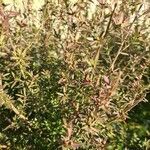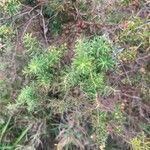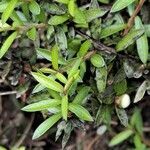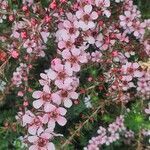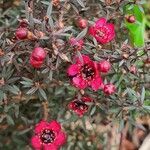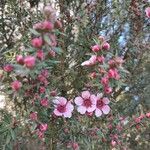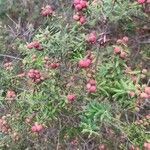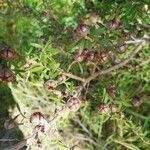Shrubs of diverse habit, or trees up to c. 4 m. tall. Bark brown, shedding in long strips. Branchlets and young lvs ± silky-hairy. Lvs subsessile, ± 4-12 × 1-4 mm., of 2 main forms on different plants-narrow-lanceolate or ovate-coriac., rigid, acute, pungent, erect to patent. Fls axillary, or occ. terminal on branchlets, sessile or nearly so, us. solitary, up to 12 mm. diam. or more. Receptacle broadly turbinate, adnate to ovary. Sepals suborbicular, soon falling; petals suborbicular, with short claw. Capsule woody, long-persistent, distinctly exserted beyond receptacle-rim, 5-valved.
A prickly shrub. It is usually upright and slender. It can grow to 2-4 m high. It spreads 80 cm to 1.2 m wide. The leaves are hard and shiny. They do not have hairs and are sword shaped. They have a sharp point. The flowers are white. They have 5 petals. There is a ring of short stamens at the base of the petals. The fruit is a round capsules. The have 5 lobes on top. They do not have hairs. There are many cultivated varieties.
Shrub to 2 m with smooth, firm bark. Leaves spreading-recurved, lanceolate, margins incurved, firm-textured, pungent, mostly 7-15 x 2-6 mm. Flowers solitary on short shoots, pink or white. Capsules woody, persistent, 8-12 mm diam.
